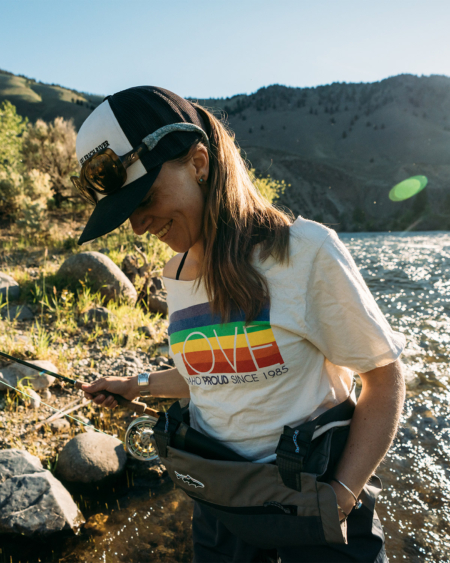Shifting Currents
Guiding queer identities in rural Idaho.
We walk down the trail toward the river because we’re fighting. The sunny afternoon is the negotiation table, the rods, already rigged, an olive branch. In our decade together, it’s not the first time we’ve used fishing to pry us out of a stalemate. Fishing is where we began, and if we ever end, it’ll probably be on some riverbank, too. The Idaho morning is crisp with the promise of winter, and the steelhead brace for a quiet season amid the ice. Before the snow flies, we both need to get out of the house and out of our heads.
On the second or third cast over the shelf, a fish links up, and my line flashes across the run. It breaks me off, but I’m grinning. My partner hooks the next one with the same result.
“We’re going to need heavier test,” he says into my hair as I push my chin into his chest, the smell of damp down jacket and him in my nose. Two great blue herons fly by, fishing today and headed south tomorrow. We walk back to the truck, the start of a truce.
I love telling fishing stories, but this isn’t one, nor is it a story about my relationship.
The fight between my partner and I began as I considered if I should write this piece. The heated words, frustration and silent treatment between us wasn’t an argument about my identity. It was a negotiation over the balance of a public writer sharing a private life. There are still economic and social consequences to queer visibility in fishing towns across the US. My relationship, queer by way of my bisexual orientation, passes as straight. We live and fish in an isolated, rural town in one of the most conservative states in the nation. It’s a place that still values homogeny and tradition over difference and change. Often, the fishing community, even in more progressive areas, is no different.
I’ve always loved the dynamism of river landscapes, and my sexual orientation feels just as fluid. I’m attracted to those of my own gender and other genders, too. It’s fishing that finally taught me to think of the structures and ecosystems beneath the surface when I look at a river. In my own river of identity flows my orientation, along with imposter syndrome, privilege, fear and the joy of being in a community of people that reflects my own experience. It feels like there is always an eddy line trying to swing me in toward the shore, and a more definitive answer of who I am and how I’m capable of loving. Instead, I stay mid-current and swim upstream.
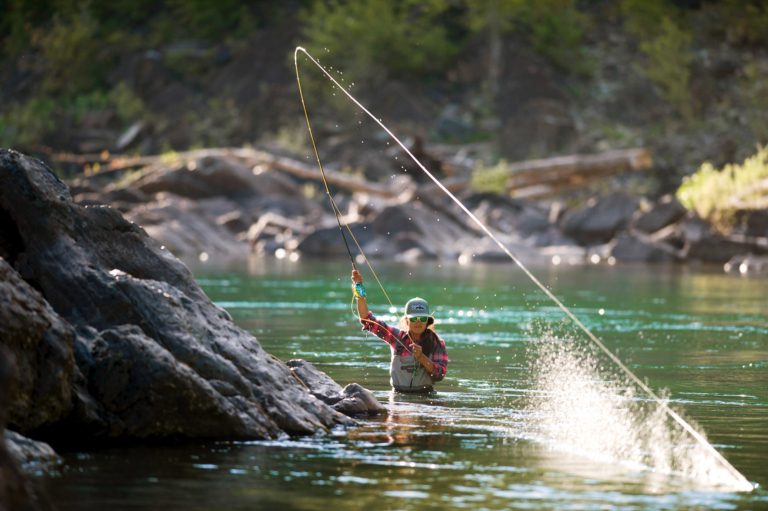
Hilary Hutcheson, an early inspiration for Emerald, sets the hook on the Middle Fork of Montana’s Flathead River. Photo: Lee Cohen
As a high schooler raised in the wheat fields of northern Idaho, I dreamed of an adulthood on rivers, of replacing waves of grain with trains of waves. Growing up in a white-water family, I had a head start. I learned how to row a boat as a preteen and ogled the river guides that floated past our wilderness camps. I was hungry for a time when I’d have outdoor peers of my own. Fishing was usually nearby but always just something for the boys, until I saw a sun-drenched Patagonia catalog image of Hilary Hutcheson setting a hook. Suddenly, my vision of rivers also included having a fly rod in hand. When I moved to the confluence town of Missoula, Montana, for my undergraduate degree, I was enamored with the endless water around me.
Loneliness and an itch to find my place marked my first few years in Montana. I leaned into an outdoors-focused identity. It wasn’t that the LGBTQ+ community wasn’t around—a gay and proudly out professor, dorm roommates dating other women, a rainbow sticker on my water bottle—but I didn’t orient myself in the community. I wanted a career outdoors. So I hustled to build my outdoor skills, river guiding during summers and soliciting invites on weekend trips to the backcountry. I generally dated men. Most people assumed I was straight, and I went with the flow. Even then, I saw who held power and opportunity in those industries, and I sensed who I would need to win over in order to receive an invitation.
Set to the backdrop of this striving college experience, I also fell in love with a handsome, straight, cisgender (a person whose gender identity matches their sex assigned at birth) fly fisherman. Within my bisexual orientation, he wasn’t an ungenuine choice. He was—and is—a catch, kind beyond his fishing lessons with a calm balance to my often-frenetic pace. I taught him to navigate white water and introduced him to guiding as he taught me how to coax cutthroat trout to a fly in clear water. I trust he loves me for my full self. But I do regret all that time not really understanding who I was, and the queer people I hurt or didn’t speak up for along the way. For years, I had my reasons for keeping quiet. Or I thought I did.
A Decade of Reasons (and Misunderstanding)
2013: My attraction to and relationships with women were just a “being in your wild 20s” phase.
2014: Fellow river guides and outfitters assumed I was straight, so I didn’t correct them.
2015: Being a young, “attractive-to-men” woman was an advantage in gaining fishing-industry opportunities.
2016: I was worried the platonic women friends I went on fishing trips with would think I was predatory or trying to score a date.
2017: Donald Trump was in office, supported enthusiastically by 73.5 percent of my rural county.
2018: I didn’t want to jeopardize my partner’s career in our small, conservative town.
2019: My river outfitter’s employee contract asked us to mute our personal beliefs about sexual orientation.
2020: I was in the weeds of LGBTQ+ academic theory, trying to untangle the meaning of labels associated with my experience.
2021: When I pitched outdoor writing to editors, they never chose the options centering on my LGBTQ+ experience.
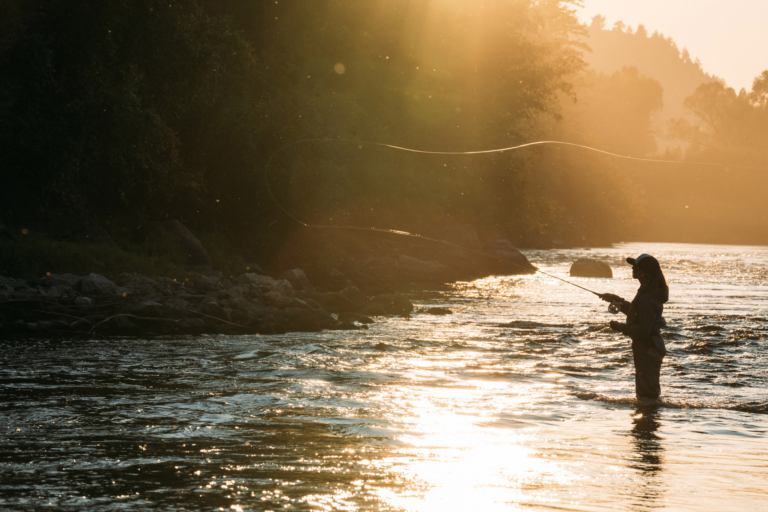
The beginning of something great. Emerald knows how to start the day off right. Photo: Leslie Hittmeier
Like an anadromous steelhead turning toward home, it was the Salmon River that brought my partner and me, both Idaho raised, back to a rural part of the state. No longer in the progressive soup of a college town, I sought my sense of self. I stayed warm by the woodstove during long winter nights and read Audre Lorde, bell hooks and Omise’eke Tinsley. I listened to Janelle Monáe and Brandi Carlile and watched my first TV series that featured an ongoing bisexual-character storyline. I first found these creators because I was trying to navigate sexism and deepen my feminism. Yet, their bold queerness answered a question I didn’t know I was asking.
Passing as straight has enormous advantages, but it’s lonely as hell. When you are feminine-presenting, bisexual and monogamous, you are often mistaken for straight or lesbian. As I understood my own place in the LGBTQ+ community, I also began to see all the times I was able to downplay my sexual orientation for the sake of my own comfort or the comfort of those around me. I’m content with where my professional and personal life have placed me so far, but I regret letting how others saw me limit who I considered myself to be.
It’s initially easy for me to blame my younger self for creating the false choice of accepting queerness or acceptance in the outdoors. Instead, I remind myself of the quieter ways heterosexist systems bubbled up in that seemingly progressive world of human-powered, outdoor sports. There was no lesbian woman ready to take me to the Bitterroot to catch my first fish on the fly, no out, queer editor reading my essays or reviewing my fish-guiding résumé. Instead, I heard gay men and lesbian women used as the core of hundreds of riverside jokes and trans folks spoken of with a sneer. Bisexuality was seen as nothing more than a way to score a threesome. I spoke up often, but not often enough, and felt the risk when I did. As I built a career in the outdoor and fishing industries, there were many signals that the more palatable, the easier to understand, the more typical I was, the more I would succeed.
I remember being in the camp kitchen with a crew of other fishing guides. We were giddy with the high of a day of big white water and bigger cutthroat trout. The conversation was congenial as I lightly commented that gender is a social construct, not something based on our anatomy. A fellow guide looked me straight in the eye and, with a sneer, said, “Tell that to my dick.” A sneer hits different when you’re deep in the backcountry with a crew of all men. When I fish guide, I usually feel safe and even accepted most days, which is likely a nod to my seniority and ability to pass as straight. I’d usually tell you these men are my friends. But I do hold a vague wariness at the base of my neck that’s hard to shake. I see how far we have to go to make these outdoor and fishing industries inclusive and welcoming to the full LGBTQ+ community.
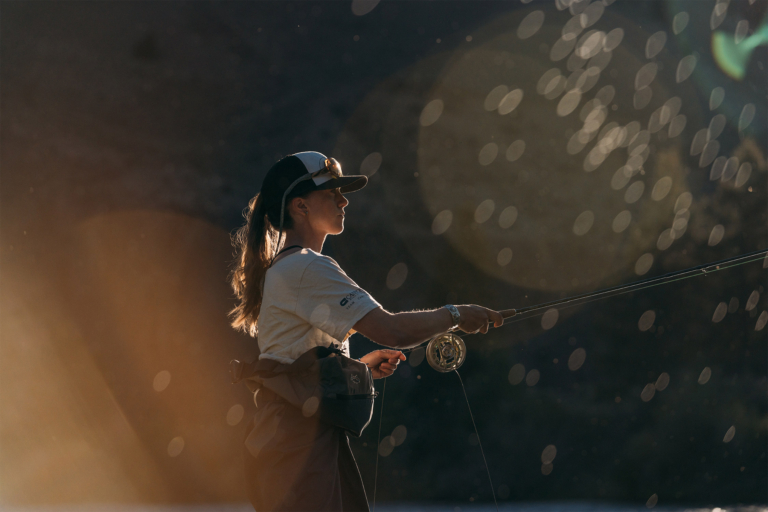
Start early, quit late and pack an extra sandwich. Emerald has the essentials covered on Idaho’s Salmon River. Photo: Leslie Hittmeier
Admitting my sexual orientation to myself was a slow wade forward, with many false starts—the girl crushes I had at 14 and the flings of my 20s were, well, crushes and flings. They were experiences as important to my sexuality as the romances I’d had with men. Under just enough internalized homophobia and denial, I missed my own queerness for years. I was socialized to see queerness as a burden, even in the instances I saw it tolerated. I was taught to ignore the currents of joy that also run through a queer identity.
I came out first to friends and loved ones, then to my professional networks. The occasional comfort of passing wasn’t worth the loneliness and the itch of small lies. I’m not the only member of the LGBTQ+ community in my small town. I’m not the only queer white-water or fly-fishing guide in my state. Many people in towns like mine hold their truth tight to their hearts, and no part of me judges them for their secrecy. There are also those that are out, who stand proud and exposed like the snow-capped mountains on the edge of the Salmon River valley. I can’t—won’t—speak for all of them. I’ll just remind you: There are already LGBTQ+ folks all around you. It’s often more a question of if they trust you enough to tell you they are there.
Many fellow queer folks, deciding the risk of violence and lack of community are dealbreakers, leave town. It’s my uncomfortable truth that by often passing as straight, I buffer myself from the worst of these realities. My anger flares as I consider the ways people are pushed from remote landscapes because they don’t feel safe there. Mingled with my rage is also a deep sadness for families divided, for youth trying to navigate rural high schools without harm, for those recovering from violent practices like conversion therapy, for the straight folks who don’t have queer people in their lives and miss out on all that love.
When I first came out, I was most scared of the queer community itself. I assumed I’d face the same skepticism as when I first tried to call myself an angler. Dating a heterosexual, cisgender man, I didn’t feel queer enough for the LGBTQ+ community. Being able to pass when convenient, I didn’t want to prioritize myself over those that experience more frequent violence and harm. I thought I’d be asked for proof of my sexuality, like I’d been asked to prove a woman fly-fish guide was as good as a man. Similar to the confusion I received when I said I both fly fish and gear fish, I figured my fluidity would cause suspicion. Succeeding in the outdoors and fly-fishing industries taught me to navigate cultures built on performed expertise and the exclusion of others. In fly fishing, I always worried my seat at the table was stolen from someone who might deserve it more. Yet, in the LGBTQ+ community, I’ve been met with only warmth and inclusion. I underestimated the deep affirmation I would find in better understanding my identity and finding others that see their world through a similar lens.
I still work to shake my anxiety. Last June, I nervously logged on to a digital campfire of the newly formed Queers & Camo, a group for LGBTQ+ hunters and anglers. As the 30-plus attendees introduced themselves from every corner of the US, I grinned. Finally confident in my sexual orientation, I’d been grappling with how to integrate my sportswoman self with my queer self and, again, had turned up resolute but lonely. From afar, I watched Pride parades in the cities and LGBTQ+ outdoor clubs form in college towns. I slipped into another dichotomy, believing I would have to choose between living in a rural, riverside place I love or participating in queer culture. In the meeting, someone described her love of bass fishing. Someone else talked about their first white-tail hunt. I felt a little less alone.
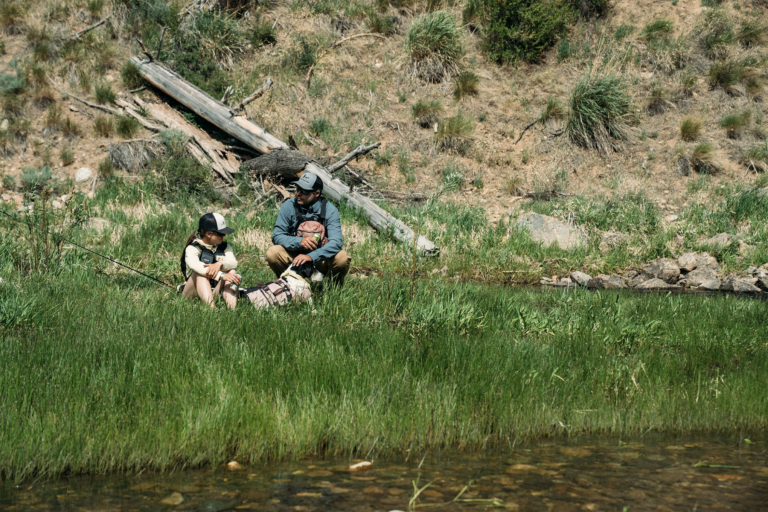
Emerald, her partner, Casey Jones, and their very good boy, Hank, toast the day on the banks of the Salmon River. Photo: Leslie Hittmeier
I have a Maya Angelou quote above my writing desk. It reads, “Well, at some point—you only are free when you realize you belong no place—you belong every place—no place at all. The price is high. The reward is great.”
I belong to myself. I belong to the Salmon River Mountains and her rivers. I speak only for my own experiences. I also strive to acknowledge my lineage of thought. The women and nonbinary folks that led me through their art to my own queerness were mostly Black activists, artists and poets. The spaces I’ve felt the least lonely are led by trans and nonbinary members of the LGBTQ+ community, who experience the most violence in rural places. In learning how to stop defining myself in relation to others, I’ve instead created the space to deeply care for others, to see my own freedom as irrevocably interwoven in theirs. I place myself alongside the LGBTQ+ community and all the others who have been excluded from the fly-fishing narrative. I feel the force of us together, like water eroding a bank, and I know we’re building a new home.
The LGBTQ+ community taught me to envision and speak the future I want us to create. I see an angler, standing knee-deep in the Salmon River, the current splitting around them. Their partner fishes, too, a few paces downstream. They set an anchor with their line, then extend a loop out over the slate-grey water. This angler chose rural Idaho and a thriving queer community, wild fish conservation and social-justice advocacy. This angler chose their partner based on how their gentle hands tie a steelhead fly, not their gender.
The two anglers climb into their dusty truck, bickering about something benign—what’s for dinner, where to fish next weekend. They pull into a convenience store parking lot. They open the door for their partner, buy a six-pack of beer, ask the cashier about church, water levels and the upcoming school board vote. They show a photo of the steelhead they landed that afternoon. Their partner looks on, grinning, amending the story when the fish tale gets too outlandish. As they exit the store, they link hands. Outside, the Idaho afternoon fades.
